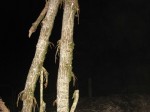
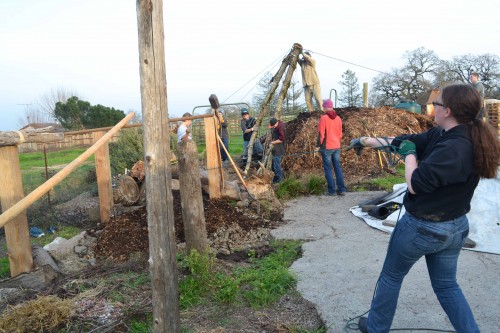 Students pull up Garter Snake Ravine’s barn owl perch using a block-and-tackle.
Students pull up Garter Snake Ravine’s barn owl perch using a block-and-tackle.
Garter Snake Ravine is a wildlife habitat installation that incorporates a deep hole cut into adobe soil, a water reservoir, a large-branches heap (BIG stick pile), a Fungus DreamWorld, and a Science Experiment.
The Laguna de Santa Rosa Foundation, operates the Laguna Environmental Center, on Stone Farm, at 900 Sanford Road, Santa Rosa, California, 95401. This wildlife habitat installation borders the LEC’s (Laguna Environmental Center’s) Native Plant Nursery, which is used for the Foundation’s Restoration Program.
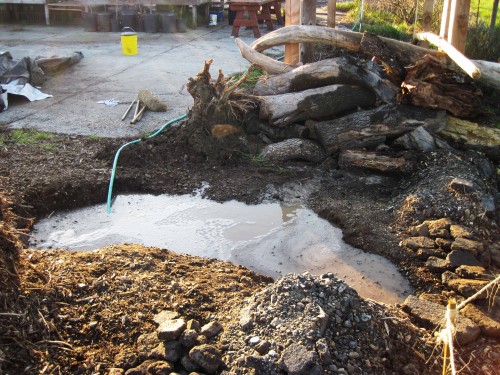 As mentioned in Spore Lore’s post, Prep for Garter Snake Ravine, 1-3-2015, the adobe hole, AKA “Ravine”, was left full of water to soften the hardpan adobe soil in the bottom of the hole. Sure enough, a week later, we were able to dig the hole another foot deeper — that much more space/capacity for the new habitat installation. The deeper hole will also give the owl perch more vertical stability; the upside down poplar tree will be buried deeper.
As mentioned in Spore Lore’s post, Prep for Garter Snake Ravine, 1-3-2015, the adobe hole, AKA “Ravine”, was left full of water to soften the hardpan adobe soil in the bottom of the hole. Sure enough, a week later, we were able to dig the hole another foot deeper — that much more space/capacity for the new habitat installation. The deeper hole will also give the owl perch more vertical stability; the upside down poplar tree will be buried deeper.
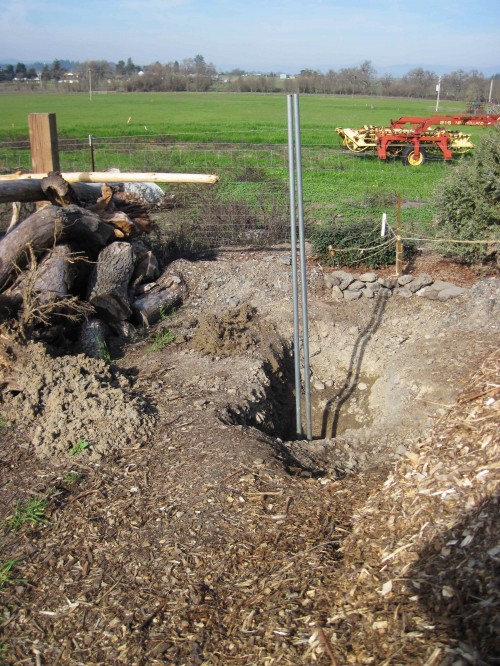 A long-handled posthole digger at the ready in Garter Snake Ravine after a week of soaking the hole with water.
A long-handled posthole digger at the ready in Garter Snake Ravine after a week of soaking the hole with water.
The dug-out adobe soil was used to raise the compost’s ground level to help keep the compost out of winter’s wet. Garter Snake Ravine is two doors down from Compost Cricket Corral; Log Pile Apartments is between them. So to review, in the photo above, the water is overflowing Garter Snake Ravine, flowing under Log Pile Apartments, and moistening the raised banks of Compost Cricket Corral BUT not saturating the compost pile because of the now raised soil level of the compost piles.
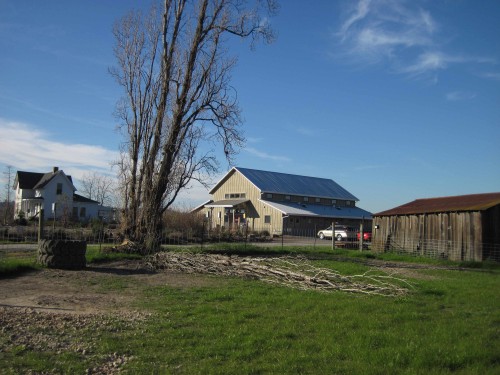 A tree has fallen! No one was there to hear it but the crushed fence leaves a reminder. The poplar tree split at its crown with the snapped-off trunk landing into the adjacent horse corral. Problem: tree in corral. Solution: we just found ourselves an owl perch.
A tree has fallen! No one was there to hear it but the crushed fence leaves a reminder. The poplar tree split at its crown with the snapped-off trunk landing into the adjacent horse corral. Problem: tree in corral. Solution: we just found ourselves an owl perch.
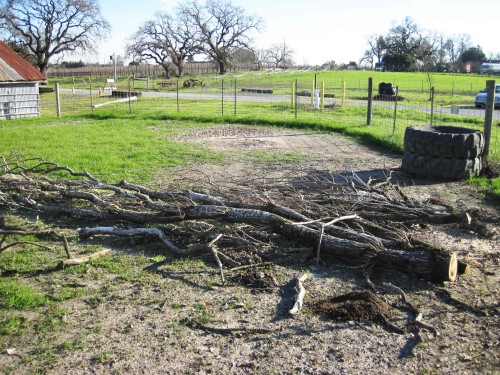 A 16-foot section of this poplar tree trunk will become an owl perch in Garter Snake Ravine wildlife habitat.
A 16-foot section of this poplar tree trunk will become an owl perch in Garter Snake Ravine wildlife habitat.
Because the tree is a poplar, we want to use it in a way that it will not sprout, thrive, and eventually shade the compost piles which are west (shady side) of Garter Snake Ravine. Poplar (Populus) trees are similar to willow trees in that they are both riparian species widely used for stream/watershed restoration. Both Poplar and willow have high levels of rooting hormone. And that’s a problem here — the Ravine habitat will be a water-/moisture-filled vase, like that for table flowers, during the coming wet months. Solution: “plant”, or install, the poplar tree upside down to prevent the rooting process. 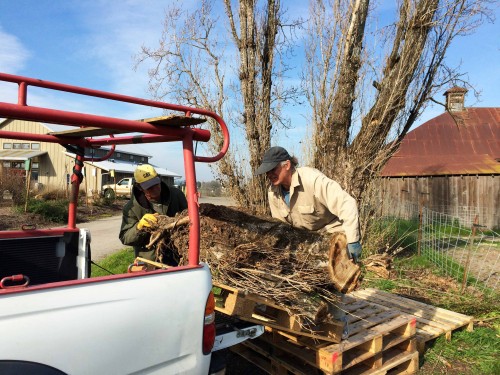 And don’t forget the trunk stump. This hulk of poplar wood will add to the habitat’s hugelkultur mass. Also, heavy, bulky pieces of wood like this one and others will help stabilize the owl perch, keep it from falling. Note how a staircase of skids was used to roll the stump into the bed trunk. Great to have a helping hand.
And don’t forget the trunk stump. This hulk of poplar wood will add to the habitat’s hugelkultur mass. Also, heavy, bulky pieces of wood like this one and others will help stabilize the owl perch, keep it from falling. Note how a staircase of skids was used to roll the stump into the bed trunk. Great to have a helping hand.
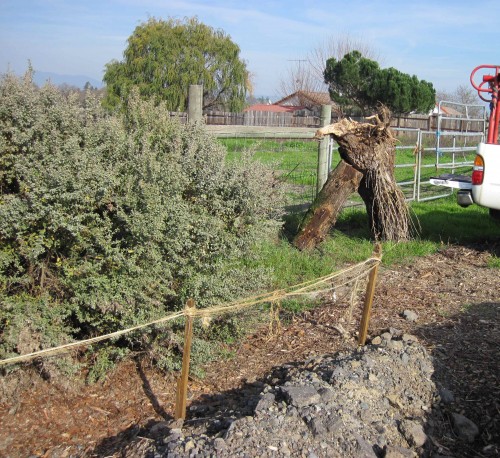 The poplar trunk stump waits on the sidelines until the owl perch is placed into the Ravine.
The poplar trunk stump waits on the sidelines until the owl perch is placed into the Ravine.
Our initial desire was to raise an owl perch high in the sky to encourage barn owls to hunt and feed at the compost pile. A perch that the barn owls that live on Stone Farm can use. That pair of barn owls (Tyto alba) can sometimes be seen in the palm trees below the Office’s front porch. Hoo called in Rodent Management?
IPM, a Permaculture term, stands for Integrated Pest Management. Rodents can be pests around a farm and Stone Farm is no exception. IPM is a way to handle one of Nature’s jobs by Nature. Traditionally, by introducing, a cure animal. Problems arise when the cure-all species becomes a problem — no other species is well suited to control the alien plant or animal. Such is part of the reason that Native Plants and IPM are considered solutions to removing pests ecologically. 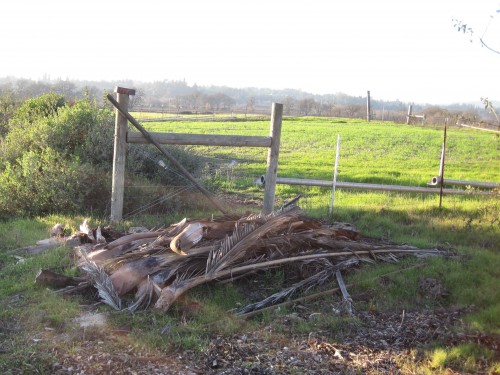 Palm fronds are not accepted in the local Resource Center, which makes soil additives from the garden debris (resource!) brought to it. But the fronds will be an asset in the hugelkultur — critters will seek the nooks and crannies between the slowly decomposing fronds.
Palm fronds are not accepted in the local Resource Center, which makes soil additives from the garden debris (resource!) brought to it. But the fronds will be an asset in the hugelkultur — critters will seek the nooks and crannies between the slowly decomposing fronds.
A bird cam is installed — the camera will be trained on the perch to view owls hunting and eating their meals.
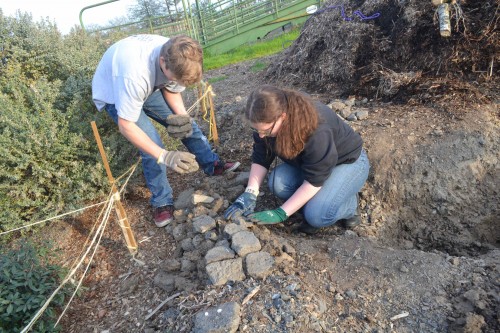 Students create a small retaining wall made from stones and heavy clay removed from the Ravine’s hole. This berm will direct runoff water under the adjacent wildlife habitat installation.
Students create a small retaining wall made from stones and heavy clay removed from the Ravine’s hole. This berm will direct runoff water under the adjacent wildlife habitat installation.
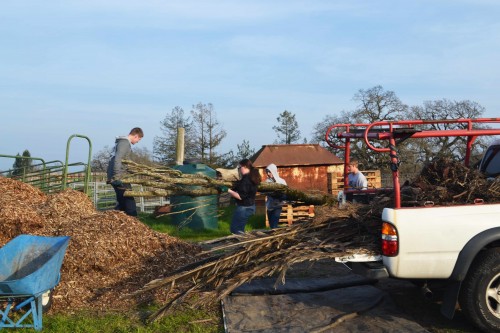 The poplar owl perch is here! Students walk the perch up the woodchip pile to gain height advantage for installing the perch into Ravine’s hole.
The poplar owl perch is here! Students walk the perch up the woodchip pile to gain height advantage for installing the perch into Ravine’s hole.
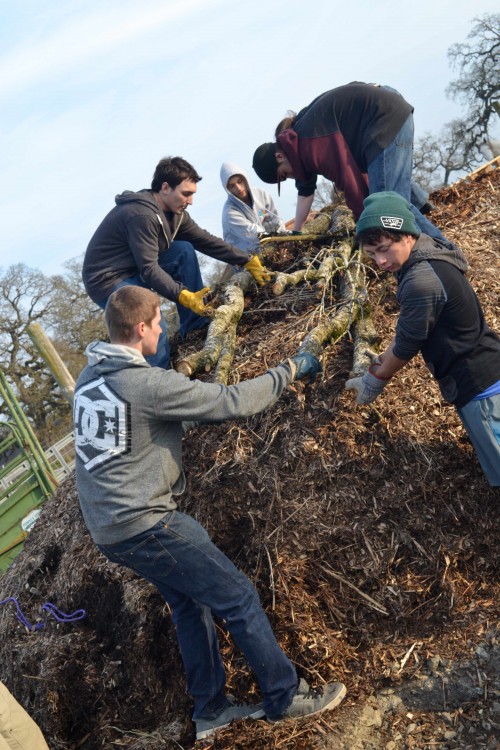 Here comes the perch, heading for Ravine’s hole. Note the thinner tree limbs in the foreground; the tree section is being flipped upside down.
Here comes the perch, heading for Ravine’s hole. Note the thinner tree limbs in the foreground; the tree section is being flipped upside down.
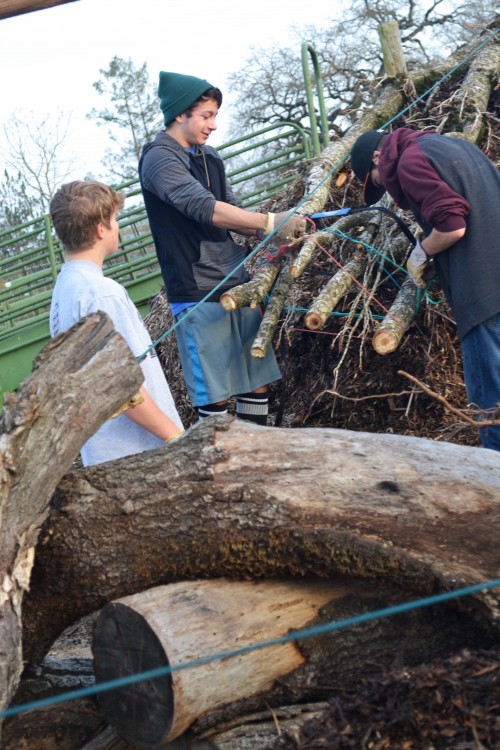 The poplar tree section’s thinner branches are tied together to better fit the upside down tree into the Ravine. Note the green rope crossing back and forth — the block and tackle is being threaded for pulling the tree vertical.
The poplar tree section’s thinner branches are tied together to better fit the upside down tree into the Ravine. Note the green rope crossing back and forth — the block and tackle is being threaded for pulling the tree vertical.
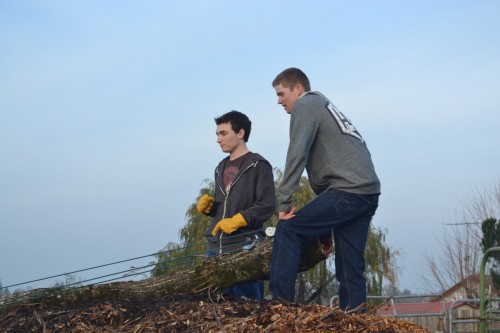 Students, on top of the woodchip pile, wait for the signal to assist the block-and-tackle’s raising of the owl perch.
Students, on top of the woodchip pile, wait for the signal to assist the block-and-tackle’s raising of the owl perch.
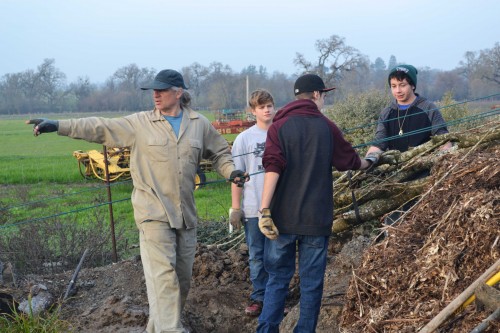 Signaling to the rope puller, “Pull in the slack, batten down the hatches.”
Signaling to the rope puller, “Pull in the slack, batten down the hatches.”
 “Pull!”, and up the perch goes with a little help from the top of the woodchip pile. Two safety lines were used in case the perch was accidently pulled past vertical. Note the safety line from the right-most student (right of the woodchip pile). The left-sided safety line is being held by a student standing behind and to the left of the woodchip pile.
“Pull!”, and up the perch goes with a little help from the top of the woodchip pile. Two safety lines were used in case the perch was accidently pulled past vertical. Note the safety line from the right-most student (right of the woodchip pile). The left-sided safety line is being held by a student standing behind and to the left of the woodchip pile.
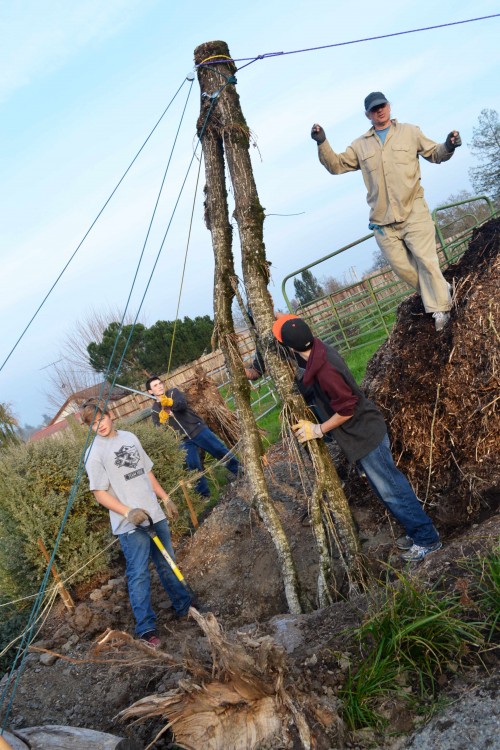 The owl perch is edged into place. The poplar tree section has been up-ended.
The owl perch is edged into place. The poplar tree section has been up-ended.
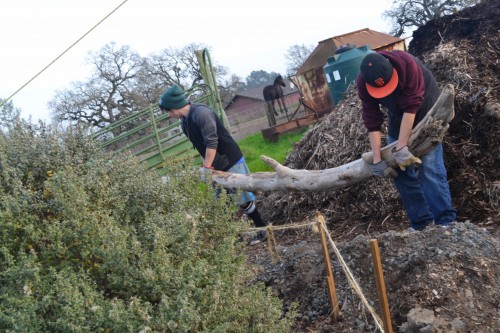 Students stuff driftwood logs, the poplar stump, palm fronds, and smaller poplar braches (upside down) around the perch to stabilize it. Plenty for all hands to do now; we want to vertically secure the perch and remove the block-and-tackle lines and safety ropes.
Students stuff driftwood logs, the poplar stump, palm fronds, and smaller poplar braches (upside down) around the perch to stabilize it. Plenty for all hands to do now; we want to vertically secure the perch and remove the block-and-tackle lines and safety ropes.
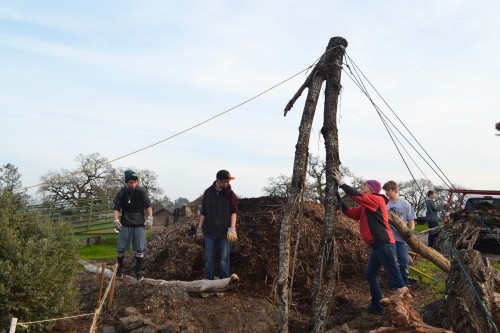 Safety check! Lookin’ good; keep packing the hole around the perch.
Safety check! Lookin’ good; keep packing the hole around the perch.
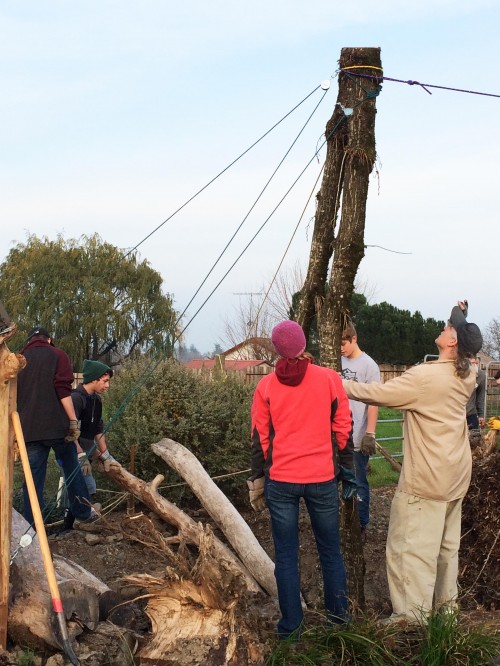 Still more materials to pack around the perch as it approaches standing on its own, without stabilizing lines.
Still more materials to pack around the perch as it approaches standing on its own, without stabilizing lines.
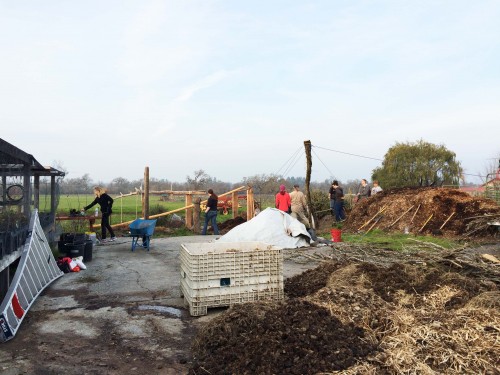 A breather while the owl perch is finalized. This outdoor classroom rocks!
A breather while the owl perch is finalized. This outdoor classroom rocks!
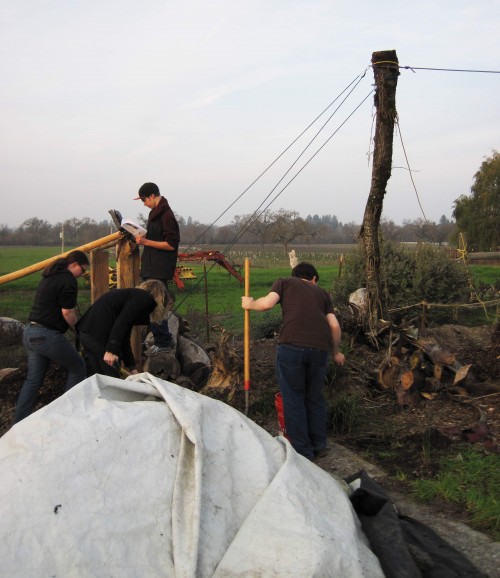 Students are busy planting Santa Barbara sedge (Carex barbarae), programming the bird cam, and packing the Ravine.
Students are busy planting Santa Barbara sedge (Carex barbarae), programming the bird cam, and packing the Ravine.
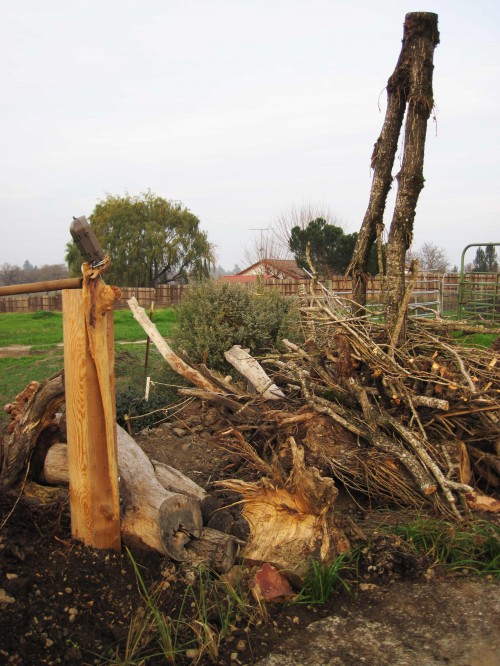 Garter Snake Ravine wildlife habitat installation is completed. Note that the habitat has three major elements: a deep moist adobe hole that will fill to a small pond during the rains, a pile of branches and sticks, and an owl perch. That’s a lot of nooks and crannies for critters to hunt, hide, cool-down, and LIVE! in. First will come the wood-eating fungi and decomposer microbes, then higher trophic critters, then perhaps a mammal (an even higher trophic animal), like a skunk or a possum, that wants to reign over the habitat.
Garter Snake Ravine wildlife habitat installation is completed. Note that the habitat has three major elements: a deep moist adobe hole that will fill to a small pond during the rains, a pile of branches and sticks, and an owl perch. That’s a lot of nooks and crannies for critters to hunt, hide, cool-down, and LIVE! in. First will come the wood-eating fungi and decomposer microbes, then higher trophic critters, then perhaps a mammal (an even higher trophic animal), like a skunk or a possum, that wants to reign over the habitat.
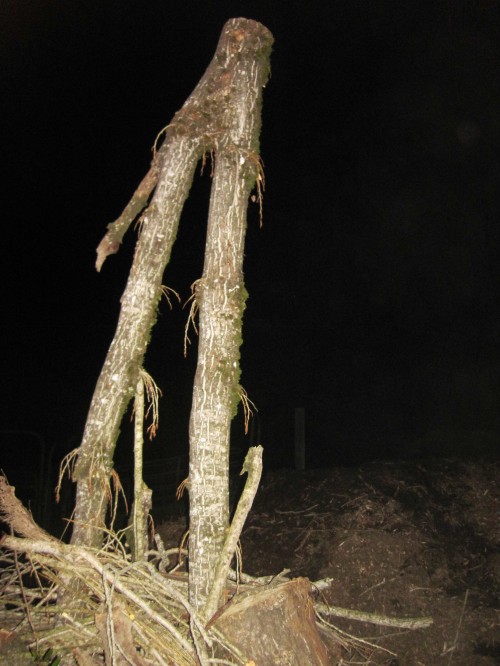 Garter Snake Ravine waits for a perching barn owl throughout the dark night.
Garter Snake Ravine waits for a perching barn owl throughout the dark night.
Thank you for the wonderful pictures, Jenna.
The students of Orchard View School, teacher Sunny Galbraith, and Cordy and David and I had fun at this outdoor classroom Biology project. A thank you also to the Laguna Foundation’s staff, especially Wendy Trowbridge, Director of Restoration and Conservation Science Programs, and Brent Reed, Restoration Projects Supervisor. Cool project!
Enjoy your wildlife habitat creations. Habitat it!
Tony
